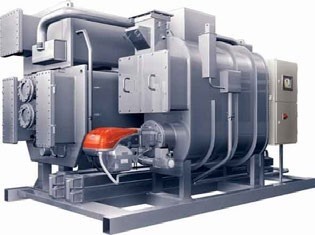District cooling Technologies
This section describes district cooling systems and the technologies generally used. These practices are mostly applicable anywhere, with minor exceptions. For example, thermal storage is more feasible in locations where electricity tariffs vary from day to day.
A district cooling system has three main components (Figure 2): a cooling source and generating plant, a cooling distribution system, and an energy transfer station with heat exchangers.
figure 2: components of District cooling systems
A district cooling system can be part of an upstream system, either supplying energy to a cooling plant or included in a cogeneration or trigeneration system. Below are some examples of upstream systems:
· heating systems
- district heating
- recovery and use of surplus heat from industry
• electricity generation systems
– electric power grid
– electricity generated directly from renewable energy sources, such as hydro, wind, and solar power
• cogeneration and trigeneration systems
– CCHP
– district heating and cooling
Directly or indirectly, the district cooling system can be based on many different fuels, such as fossil fuels (coal, oil, gas); renewable energy (biomass, wind, solar, hydro, geothermal energy); and energy from municipal solid waste and industrial waste. The efficiency of district cooling technologies, which varies widely, determines the extent of emissions from the district cooling system, in combination with the fuels used.
a. Cooling Source and Generating Plant
The plant can be equipped with compressor chillers, heat-driven absorption chillers, or heat exchangers (for free cooling; see below), or with a combination of these technologies. The cooling source and the major equipment in the plant will depend on available resources and their cost, and on local conditions.
In addition, thermal energy storage will optimize the performance of the chillers, enable the plant to use cheaper electricity when prices go down, and act as cooling source during periods of peak demand or provide cooling redundancy and thereby reduce the required chiller capacity.
Compressor chillers. A compressor chiller is similar to a heat pump with a compressor, a condenser, an expansion valve, and an evaporator. Compressor chillers use different types of heat sinks, or passive heat exchangers (Figure 3). The most common heat sinks for district cooling projects are air, wastewater, river water, lake water, seawater, groundwater, and treated sewage water.
Absorption chillers: An absorption chiller is similar to a compressor chiller, where the compressor has been replaced by an arrangement of generator, pump, absorber and absorbent (Figure 4). Instead of a compressor driven by electricity or steam, the absorption chiller uses hot media—commonly steam, hot water, or gas—to drive the cycle. Heat sinks used for absorption chillers are similar to compressor chillers (described above).
www.bilkargroup.com
www.bilkarsogutma.com.tr
info@bilkargroup.com
+90 212 343 50 40
+90 553 343 50 40



Hiç yorum yok:
Yorum Gönder